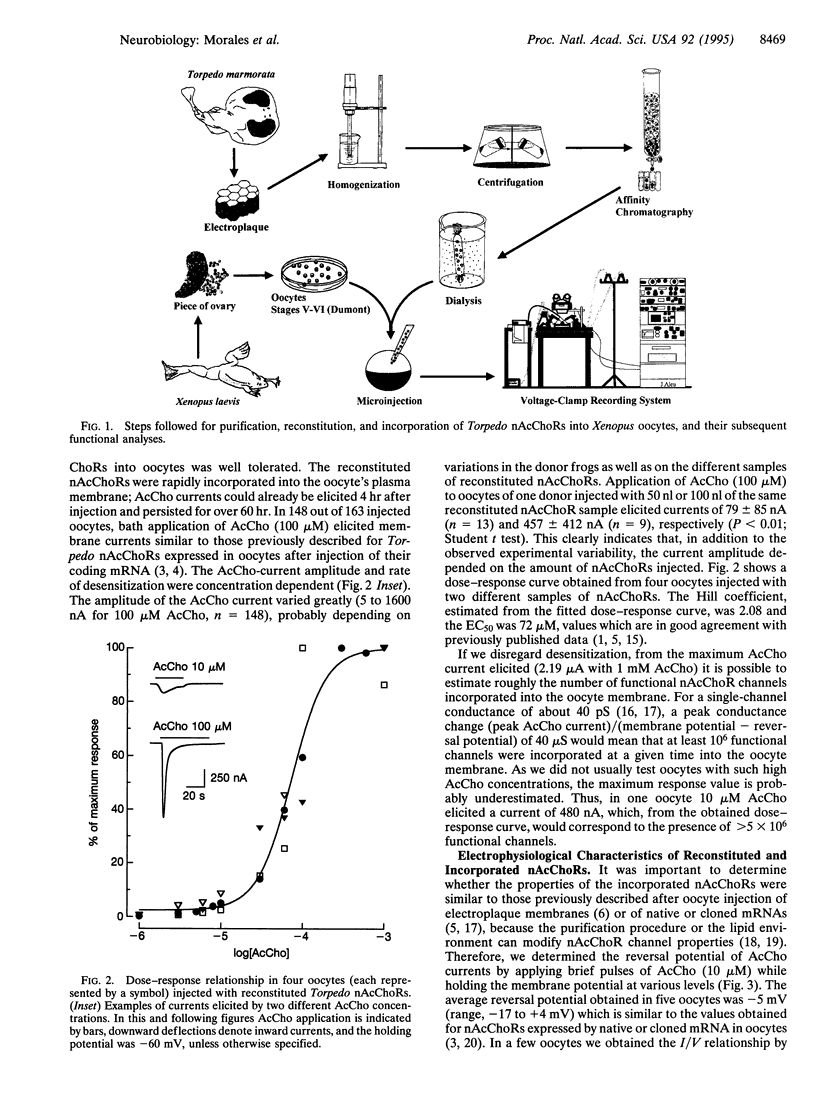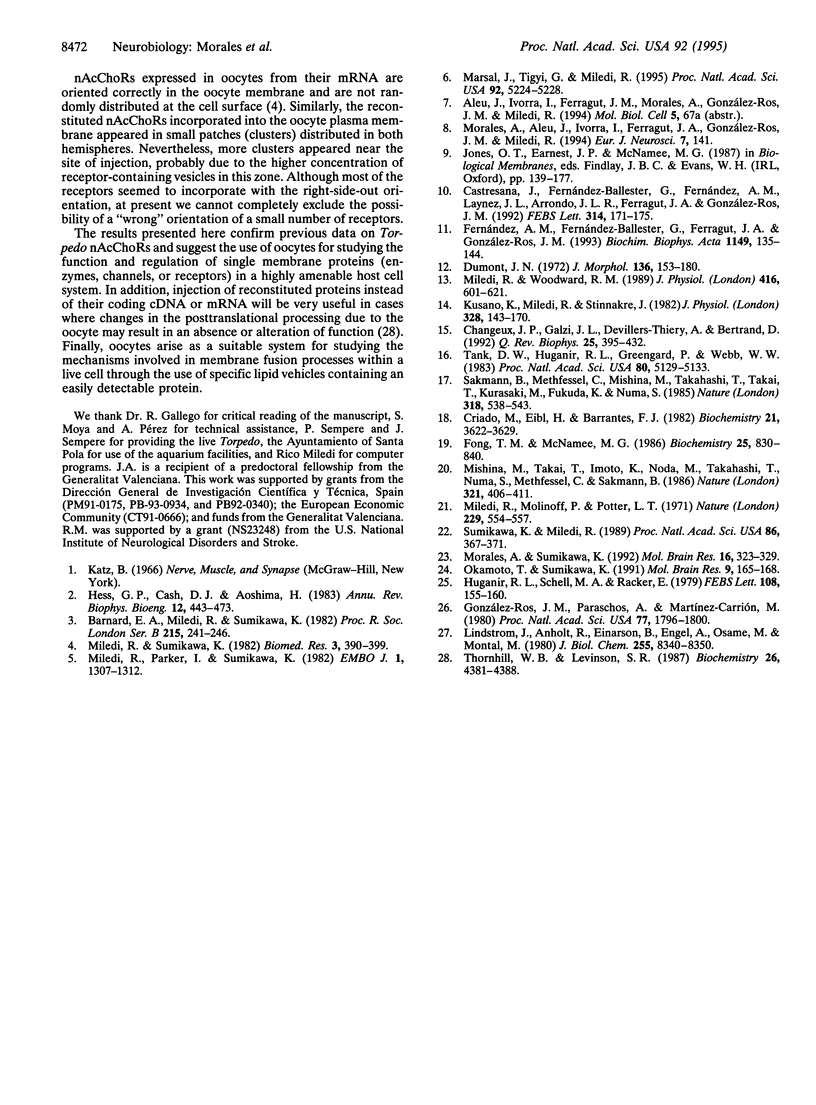Abstract
Xenopus oocytes are a valuable aid for studying the molecular structure and function of ionic channels and neurotransmitter receptors. Their use has recently been extended by the demonstration that oocytes can incorporate foreign membranes carrying preassembled receptors and channels. Here we show that when reconstituted in an artificial lipid matrix and injected into Xenopus oocytes, purified nicotinic acetylcholine receptors are efficiently inserted into the plasma membrane, where they form "clusters" of receptors that retain their native properties. This constitutes an innovative approach that, besides allowing the analyses of membrane fusion processes, is also a powerful technique for studying the characteristics and regulation of many membrane proteins (with their native stoichiometry and configuration) upon reinsertion into the membrane of a very convenient host cell system.
Full text
PDF




Images in this article
Selected References
These references are in PubMed. This may not be the complete list of references from this article.
- Barnard E. A., Miledi R., Sumikawa K. Translation of exogenous messenger RNA coding for nicotinic acetylcholine receptors produces functional receptors in Xenopus oocytes. Proc R Soc Lond B Biol Sci. 1982 May 22;215(1199):241–246. doi: 10.1098/rspb.1982.0040. [DOI] [PubMed] [Google Scholar]
- Castresana J., Fernandez-Ballester G., Fernandez A. M., Laynez J. L., Arrondo J. L., Ferragut J. A., Gonzalez-Ros J. M. Protein structural effects of agonist binding to the nicotinic acetylcholine receptor. FEBS Lett. 1992 Dec 14;314(2):171–175. doi: 10.1016/0014-5793(92)80967-l. [DOI] [PubMed] [Google Scholar]
- Changeux J. P., Galzi J. L., Devillers-Thiéry A., Bertrand D. The functional architecture of the acetylcholine nicotinic receptor explored by affinity labelling and site-directed mutagenesis. Q Rev Biophys. 1992 Nov;25(4):395–432. doi: 10.1017/s0033583500004352. [DOI] [PubMed] [Google Scholar]
- Criado M., Eibl H., Barrantes F. J. Effects of lipids on acetylcholine receptor. Essential need of cholesterol for maintenance of agonist-induced state transitions in lipid vesicles. Biochemistry. 1982 Jul 20;21(15):3622–3629. doi: 10.1021/bi00258a015. [DOI] [PubMed] [Google Scholar]
- Dumont J. N. Oogenesis in Xenopus laevis (Daudin). I. Stages of oocyte development in laboratory maintained animals. J Morphol. 1972 Feb;136(2):153–179. doi: 10.1002/jmor.1051360203. [DOI] [PubMed] [Google Scholar]
- Fernandez A. M., Fernandez-Ballester G., Ferragut J. A., Gonzalez-Ros J. M. Labeling of the nicotinic acetylcholine receptor by a photoactivatable steroid probe: effects of cholesterol and cholinergic ligands. Biochim Biophys Acta. 1993 Jun 18;1149(1):135–144. doi: 10.1016/0005-2736(93)90034-w. [DOI] [PubMed] [Google Scholar]
- Fong T. M., McNamee M. G. Correlation between acetylcholine receptor function and structural properties of membranes. Biochemistry. 1986 Feb 25;25(4):830–840. doi: 10.1021/bi00352a015. [DOI] [PubMed] [Google Scholar]
- Gonzalez-Ros J. M., Paraschos A., Martinez-Carrion M. Reconstitution of functional membrane-bound acetylcholine receptor from isolated Torpedo californica receptor protein and electroplax lipids. Proc Natl Acad Sci U S A. 1980 Apr;77(4):1796–1800. doi: 10.1073/pnas.77.4.1796. [DOI] [PMC free article] [PubMed] [Google Scholar]
- Hess G. P., Cash D. J., Aoshima H. Acetylcholine receptor-controlled ion translocation: chemical kinetic investigations of the mechanism. Annu Rev Biophys Bioeng. 1983;12:443–473. doi: 10.1146/annurev.bb.12.060183.002303. [DOI] [PubMed] [Google Scholar]
- Huganir R. L., Schell M. A., Racker E. Reconstitution of the purified acetylcholine receptor from Torpedo californica. FEBS Lett. 1979 Dec 1;108(1):155–160. doi: 10.1016/0014-5793(79)81199-0. [DOI] [PubMed] [Google Scholar]
- Kusano K., Miledi R., Stinnakre J. Cholinergic and catecholaminergic receptors in the Xenopus oocyte membrane. J Physiol. 1982 Jul;328:143–170. doi: 10.1113/jphysiol.1982.sp014257. [DOI] [PMC free article] [PubMed] [Google Scholar]
- Lindstrom J., Anholt R., Einarson B., Engel A., Osame M., Montal M. Purification of acetylcholine receptors, reconstitution into lipid vesicles, and study of agonist-induced cation channel regulation. J Biol Chem. 1980 Sep 10;255(17):8340–8350. [PubMed] [Google Scholar]
- Marsal J., Tigyi G., Miledi R. Incorporation of acetylcholine receptors and Cl- channels in Xenopus oocytes injected with Torpedo electroplaque membranes. Proc Natl Acad Sci U S A. 1995 May 23;92(11):5224–5228. doi: 10.1073/pnas.92.11.5224. [DOI] [PMC free article] [PubMed] [Google Scholar]
- Miledi R., Molinoff P., Potter L. T. Isolation of the cholinergic receptor protein of Torpedo electric tissue. Nature. 1971 Feb 19;229(5286):554–557. doi: 10.1038/229554a0. [DOI] [PubMed] [Google Scholar]
- Miledi R., Parker I., Sumikawa K. Properties of acetylcholine receptors translated by cat muscle mRNA in Xenopus oocytes. EMBO J. 1982;1(11):1307–1312. doi: 10.1002/j.1460-2075.1982.tb01315.x. [DOI] [PMC free article] [PubMed] [Google Scholar]
- Miledi R., Woodward R. M. Effects of defolliculation on membrane current responses of Xenopus oocytes. J Physiol. 1989 Sep;416:601–621. doi: 10.1113/jphysiol.1989.sp017780. [DOI] [PMC free article] [PubMed] [Google Scholar]
- Mishina M., Takai T., Imoto K., Noda M., Takahashi T., Numa S., Methfessel C., Sakmann B. Molecular distinction between fetal and adult forms of muscle acetylcholine receptor. Nature. 1986 May 22;321(6068):406–411. doi: 10.1038/321406a0. [DOI] [PubMed] [Google Scholar]
- Morales A., Sumikawa K. Desensitization of junctional and extrajunctional nicotinic ACh receptors expressed in Xenopus oocytes. Brain Res Mol Brain Res. 1992 Dec;16(3-4):323–329. doi: 10.1016/0169-328x(92)90242-4. [DOI] [PubMed] [Google Scholar]
- Okamoto T., Sumikawa K. Antibiotics cause changes in the desensitization of ACh receptors expressed in Xenopus oocytes. Brain Res Mol Brain Res. 1991 Jan;9(1-2):165–168. doi: 10.1016/0169-328x(91)90144-m. [DOI] [PubMed] [Google Scholar]
- Sakmann B., Methfessel C., Mishina M., Takahashi T., Takai T., Kurasaki M., Fukuda K., Numa S. Role of acetylcholine receptor subunits in gating of the channel. Nature. 1985 Dec 12;318(6046):538–543. doi: 10.1038/318538a0. [DOI] [PubMed] [Google Scholar]
- Sumikawa K., Miledi R. Change in desensitization of cat muscle acetylcholine receptor caused by coexpression of Torpedo acetylcholine receptor subunits in Xenopus oocytes. Proc Natl Acad Sci U S A. 1989 Jan;86(1):367–371. doi: 10.1073/pnas.86.1.367. [DOI] [PMC free article] [PubMed] [Google Scholar]
- Tank D. W., Huganir R. L., Greengard P., Webb W. W. Patch-recorded single-channel currents of the purified and reconstituted Torpedo acetylcholine receptor. Proc Natl Acad Sci U S A. 1983 Aug;80(16):5129–5133. doi: 10.1073/pnas.80.16.5129. [DOI] [PMC free article] [PubMed] [Google Scholar]
- Thornhill W. B., Levinson S. R. Biosynthesis of electroplax sodium channels in Electrophorus electrocytes and Xenopus oocytes. Biochemistry. 1987 Jul 14;26(14):4381–4388. doi: 10.1021/bi00388a029. [DOI] [PubMed] [Google Scholar]



